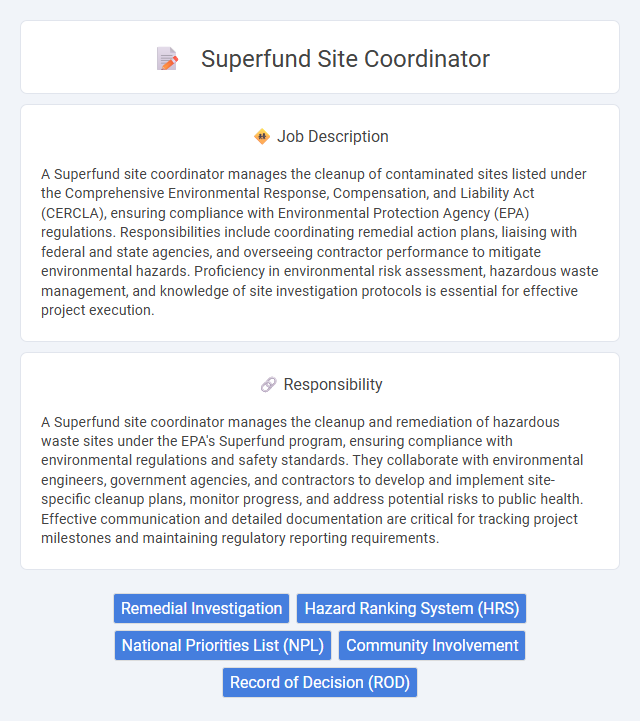
A Superfund site coordinator manages the cleanup of contaminated sites listed under the Comprehensive Environmental Response, Compensation, and Liability Act (CERCLA), ensuring compliance with Environmental Protection Agency (EPA) regulations. Responsibilities include coordinating remedial action plans, liaising with federal and state agencies, and overseeing contractor performance to mitigate environmental hazards. Proficiency in environmental risk assessment, hazardous waste management, and knowledge of site investigation protocols is essential for effective project execution.
Individuals with strong organizational skills and attention to detail are likely to be suitable for a Superfund site coordinator role, as the job requires managing complex environmental cleanup projects. Those who can handle stress and work collaboratively with government agencies, contractors, and stakeholders might find this position appropriate for their capabilities. People with limited patience for regulatory processes or poor communication skills may struggle to succeed in this demanding and highly structured job environment.
Qualification
Superfund site coordinators typically require a bachelor's degree in environmental science, engineering, or a related field, with many employers preferring candidates with a master's degree or specialized certifications such as Certified Hazardous Materials Manager (CHMM). Extensive knowledge of environmental regulations like CERCLA and experience in project management and hazardous waste site assessment are essential for effective site coordination. Strong analytical skills, proficiency with GIS and environmental data software, and the ability to liaise with government agencies and contractors are critical qualifications for this role.
Responsibility
A Superfund site coordinator manages the cleanup and remediation of hazardous waste sites under the EPA's Superfund program, ensuring compliance with environmental regulations and safety standards. They collaborate with environmental engineers, government agencies, and contractors to develop and implement site-specific cleanup plans, monitor progress, and address potential risks to public health. Effective communication and detailed documentation are critical for tracking project milestones and maintaining regulatory reporting requirements.
Benefit
Superfund site coordinators are likely to receive comprehensive health benefits and retirement plans, reflecting the federal or state government roles they often occupy. They may also benefit from opportunities for professional development and specialized training in hazardous waste management. The job's stability and potential for career advancement could provide long-term financial and job security advantages.
Challenge
A Superfund site coordinator probably faces significant challenges related to managing complex environmental cleanup projects that involve hazardous waste and multiple stakeholders. Navigating regulatory requirements while ensuring safety and compliance likely demands strong problem-solving and communication skills. Conflicts between responsible parties and community concerns may further complicate project timelines and outcomes.
Career Advancement
Superfund site coordinators manage hazardous waste cleanup projects, gaining expertise in environmental regulations, project management, and interagency collaboration. Mastering risk assessment and remediation techniques opens opportunities for senior environmental consultant, project manager, or policy advisor roles. Continued certification and specialized training enhance prospects for leadership positions within EPA or environmental consulting firms.
Key Terms
Remedial Investigation
A Superfund site coordinator specializing in Remedial Investigation manages comprehensive site assessments to identify hazardous contamination levels, sources, and pathways at designated Superfund sites. This role involves coordinating field investigations, collecting soil, groundwater, and sediment samples, and analyzing data to develop risk assessments for effective remediation planning. Expertise in EPA guidelines, environmental regulations, and data management software ensures accurate reporting and supports decision-making for site cleanup and long-term monitoring.
Hazard Ranking System (HRS)
Superfund site coordinators utilize the Hazard Ranking System (HRS) to assess and prioritize contaminated sites based on potential risks to human health and the environment. They analyze data from multiple exposure pathways, including groundwater, surface water, soil, and air, to calculate site scores that determine eligibility for the National Priorities List (NPL). Proficiency in HRS methodology ensures accurate site evaluations, enabling effective remediation strategies and regulatory compliance under the Comprehensive Environmental Response, Compensation, and Liability Act (CERCLA).
National Priorities List (NPL)
The Superfund Site Coordinator manages the identification, assessment, and cleanup of hazardous waste sites listed on the National Priorities List (NPL) to protect public health and the environment. This role involves coordinating activities among federal, state, and local agencies to ensure compliance with the Comprehensive Environmental Response, Compensation, and Liability Act (CERCLA) regulations. Expertise in environmental risk assessment, remediation technologies, and community engagement is essential for effective management of NPL site cleanup projects.
Community Involvement
Superfund site coordinators actively engage local communities by organizing public meetings and facilitating transparent communication about contamination risks and cleanup progress. They collaborate with residents, local officials, and environmental groups to address concerns and promote informed decision-making throughout the remediation process. Effective community involvement fosters trust and ensures that stakeholder input shapes site management strategies.
Record of Decision (ROD)
Superfund site coordinators manage the environmental cleanup process, ensuring adherence to the Record of Decision (ROD) issued by the Environmental Protection Agency (EPA). The ROD outlines the selected remedial actions based on comprehensive site assessments and public input, guiding the cleanup priorities and regulatory compliance. Coordinators facilitate communication between stakeholders, oversee remedial activities, and ensure timely implementation of the ROD's requirements to mitigate hazardous contamination effectively.
 kuljobs.com
kuljobs.com